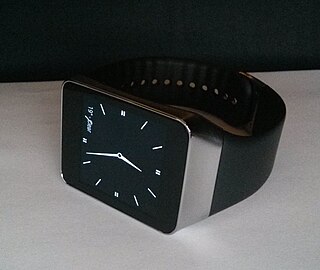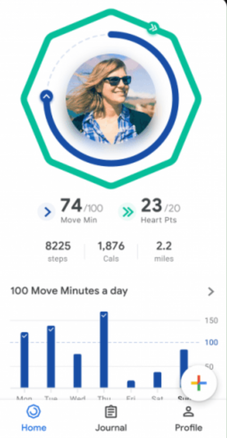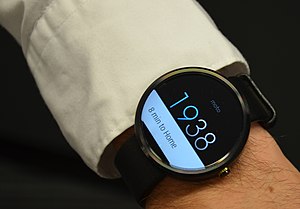
Motorola Mobility LLC, marketed as Motorola, is an American consumer electronics manufacturer primarily producing smartphones and other mobile devices running Android. Headquartered at Merchandise Mart in Chicago, Illinois, it is a subsidiary of the Chinese technology company Lenovo.

A smartwatch is a portable wearable computer device in the form of a wristwatch. Most modern smartwatches are operated via a touchscreen, and are often reliant on mobile apps that run on a connected device such as a smartphone to provide some core functions.

The Sony SmartWatch is a line of wearable devices developed and marketed by Sony Mobile from 2012 to 2016 through three generations. They connect to Android smartphones and can display information such as Twitter feeds and SMS messages, among other things.

Android Jelly Bean is the codename given to the tenth version of the Android mobile operating system developed by Google, spanning three major point releases. Among the devices that launched with Android 4.1 to 4.3 are the Nexus 7 (2012), Nexus 4, Nexus 10, Nexus 7 (2013), and Hyundai Play X.

The MetaWatch is a brand name of discontinued smartwatches developed by Meta Watch, Ltd. Strata MetaWatch and Frame MetaWatch are digital smartwatches released in 2012, funded by raising money via the crowd funding platform Kickstarter. MetaWatch was a company founded by former Fossil engineers.

The Samsung Galaxy Gear is a smartwatch produced by Samsung Electronics in the Samsung Gear family of devices. Unveiled during a Samsung Unpacked event in Berlin, Germany on September 4, 2013, the device serves as a companion for all Samsung Galaxy smartphones and tablets which runs on Android 4.3 "Jelly Bean" or newer. It was released on September 25, 2013. Originally released as an Android-based device, Samsung replaced the operating system with Tizen through the May 2014 software update.

Wear OS is a version of Google's Android operating system designed for smartwatches and other wearables. By pairing with mobile phones running Android version 6.0 "Marshmallow" or newer, or iOS version 10.0 or newer with limited support from Google's pairing application, Wear OS integrates Google Assistant technology and mobile notifications into a smartwatch form factor. Wear OS is closed-source, in contrast to the free and open-source Android.

The Samsung Gear Live is an Android Wear-based smartwatch announced and released by Samsung and Google on June 25, 2014. It was released along with the LG G Watch as launch devices for Android Wear, a modified version of Android designed specifically for smartwatches and other wearables. Gear Live is the 5th device launched in the Samsung Gear family of wearables. It is compatible with all smartphones running Android 4.3 or higher that support Bluetooth Smart.

Google Fit is a health-tracking platform developed by Google for the Android operating system, Wear OS, and iOS. It is a single set of APIs that blends data from multiple apps and devices. Google Fit uses sensors in a user's activity tracker or mobile device to record physical fitness activities, which are measured against the user's fitness goals to provide a comprehensive view of their fitness.

The LG G Watch R is an Android Wear-based smartwatch announced and released by LG and Google on October 25, 2014. It is the second round-faced smartwatch after the Motorola Moto 360 but, unlike the 360, it is the first to feature a full circular display. It is the successor to LG's original LG G Watch, which features a rectangular display.

The second generation Moto X, marketed as moto X and referred to in the media as Moto X (2014), is an Android smartphone developed by Motorola Mobility. Released on September 5, 2014, it is the successor to the original Moto X released in 2013. It was succeeded by the third generation Moto X Style and Play family, announced on July 29, 2015.

The Huawei Watch and latest Huawei Watch 4 series are HarmonyOS-based smartwatches developed by Huawei. The Huawei Watch is the first smartwatch produced by Huawei. It was announced at the 2015 Mobile World Congress and released at IFA Berlin on September 2nd. The Huawei Watch 3 was introduced in June 2021 after the United States Department of Commerce added Huawei to its Entity List in May 2019.
The Moto 360 , also known as the Moto 360 (2015), is an Android Wear-based smartwatch. It was announced on September 14, 2015 at the IFA.

The Moto G4 is a line of Android smartphones manufactured by Motorola Mobility, a subsidiary of Lenovo. It is the successor to the third-generation Moto G, and was first released in Brazil and India on May 17, 2016, with other markets following.

Moto Z is an Android smartphone developed by Motorola Mobility. Unveiled on June 9, 2016, as its flagship model for the year, the Moto Z is distinguished by the "Moto Mods" technosystem which allows case accessories to be magnetically attached to the device to provide additional functionality. The Moto Z was later joined by the more rugged Moto Z Force of which shares most of the same internals as the former, and the mid-range Moto Z Play with downgraded specifications, all three devices being compatible with the modular system.

Iqbal Arshad is an American engineer, inventor, speaker and technology executive. He has served as the senior vice president of engineering and global product development at Motorola Mobility, Google and Lenovo, and has been responsible for design and development of industry-leading smartphones, tablets smartwatches, wearables, silicon, and mobile computing technologies.
The 2019Motorola Razr is an Android foldable smartphone produced by Motorola Mobility. Unveiled on November 14, 2019, it was released on February 6, 2020. The device is designed to be reminiscent of the original Motorola Razr feature phone series and features a horizontally foldable screen. An updated version of the phone, Motorola Razr 5G, was announced on September 9, 2020, and released on September 15 of that year.
The Motorola Edge (2020) and Edge+ (2020) are Android smartphones developed by Motorola Mobility, a subsidiary of Lenovo.

The Samsung Galaxy Watch 3 is a smartwatch developed by Samsung Electronics that was released on August 5, 2020 at Samsung's Unpacked Event alongside the flagships of the Galaxy Note series and Galaxy Z series, i.e., the Samsung Galaxy Note 20 and Samsung Galaxy Z Fold 2, respectively.

The Pixel Watch is a Wear OS smartwatch designed, developed, and marketed by Google as part of the Google Pixel product line. First previewed in May 2022 during the Google I/O keynote, it features a round dome-shaped display as well as deep integration with Fitbit, which Google acquired in 2021. Two Pixel-branded smartwatches had been in development at Google by July 2016, but were canceled ahead of their release due to hardware chief Rick Osterloh's concerns that they did not fit well with other Pixel devices. Development on a new Pixel-branded watch began shortly after Google's acquisition of Fitbit.
















